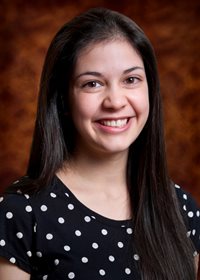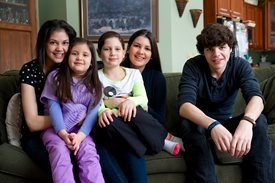Miracle Kid: Alyssa Morales
Strength and Family Key to Recovering from Eating Disorder
 At 12, Alyssa Morales was a stellar seventh-grade student and one of the top athletes on her track team. When she started spending more time in her room and became less chatty with friends and family, her parents initially chalked up her behavior changes to her recent transition into middle school, a predictably awkward time.
At 12, Alyssa Morales was a stellar seventh-grade student and one of the top athletes on her track team. When she started spending more time in her room and became less chatty with friends and family, her parents initially chalked up her behavior changes to her recent transition into middle school, a predictably awkward time.
But then she began losing weight. As Alyssa stopped playing with her four siblings and joking around and, in some cases, communicating altogether, her skin turned gray and her eyes became sunken. She eventually lost 23 percent of her body weight and was referred to Golisano Children’s Hospital at the University of Rochester Medical Center, where she was admitted to its comprehensive Child and Adolescent Eating Disorder Program. The program at Golisano Children’s Hospital is a premiere treatment center for eating disorders and receives referrals from across New York state and Pennsylvania.
Diagnosed with anorexia nervosa, Alyssa was eventually hospitalized several times, the first time for 17 days. She moved from a liquid diet to solid meals, received daily cognitive-behavioral therapy, worked with a dietitian, received inspiration from a “recovery CD” made by a music therapist and featuring some of her favorite songs, and learned that asking for assistance – a difficult thing for people with eating disorders to do because they have a desire to be perfect – isn’t a sign of weakness.
In the meantime, Alyssa’s family, from Spencerport, received an equal amount of education about an illness with a typically lengthy and arduous course of treatment.
“It was like walking into a nightmare, and they set the standard as far as the handholding we received,” Michelle Morales, Alyssa’s mom, said of the program’s team of medical professionals. “With an eating disorder, you have an initial protocol for treatment, but unlike with cancer or diabetes or another illness, there isn’t anything afterward that you can be looking for to help you know your child is getting better. We were overwhelmed, but they gave us the support we needed so we could give our daughter the support she needed.”
 Tony Morales, Alyssa’s father, appreciated that despite an extensive travel schedule for work, he was able to meet with doctors and participate in Alyssa’s therapy sessions via Skype and Google video. “Mental health continues to get less attention and care in our society, but not at Golisano,” he said. “Everyone there truly understands and cares.”
Tony Morales, Alyssa’s father, appreciated that despite an extensive travel schedule for work, he was able to meet with doctors and participate in Alyssa’s therapy sessions via Skype and Google video. “Mental health continues to get less attention and care in our society, but not at Golisano,” he said. “Everyone there truly understands and cares.”
Because of the persistent nature of the illness, Alyssa was hospitalized several times, and lived for six weeks at a residential treatment facility for children with eating disorders.
“As horrific as it was for us to be going in and out, the bottom line was that the people at Golisano were able to get to know Alyssa,” Michelle said. “You have to think of it as peeling an onion. Every time she was admitted, a new layer was removed and more information was extracted, so it helped to continue the healing process.”
Richard Kreipe, M.D., director of the Child and Adolescent Eating Disorder Program, emphasized that, like most patients, Alyssa had a difficult recovery. “But at each phase she showed progress from the phase before,” said Kreipe, who is also the Dr. Elizabeth R. McAnarney Professor in Pediatrics Funded by Roger & Carolyn Friedlander. Four years after being diagnosed, and with extensive and sometimes exhaustive treatment, she is confident and knows what needs to be done to keep recovery moving forward.”
Part of that recovery has included a dogged determination on Alyssa’s part to share her story, to help others feel less alone and, ultimately, reach out for help.
 Suzanne Bumpus, F.N.P.-C., nurse practitioner for the Child and Adolescent Eating Disorder Program, has noticed a connection between Alyssa’s progress and her increasing desire to raise awareness, particularly among those who have little or no understanding of how much pain and suffering accompanies this diagnosis. Sharing her story, Bumpus said, has given Alyssa “the ability to re-examine her journey and question ambivalence...She is now able to nourish not only her body, but her incredible spirit.”
Suzanne Bumpus, F.N.P.-C., nurse practitioner for the Child and Adolescent Eating Disorder Program, has noticed a connection between Alyssa’s progress and her increasing desire to raise awareness, particularly among those who have little or no understanding of how much pain and suffering accompanies this diagnosis. Sharing her story, Bumpus said, has given Alyssa “the ability to re-examine her journey and question ambivalence...She is now able to nourish not only her body, but her incredible spirit.”
For Alyssa, who has taken her message for greater awareness to state lawmakers, being honest about her setbacks and continued efforts to stay healthy is a way to give hope to others who feel that their identity is tied to the disorder. “I want them to know they have so much to give the world,” she said. “I want them to know they’re worth every second of every day, and that recovery isn’t as bad as the eating disorder makes it out to be.”
Now 16, Alyssa credits the encouragement and comfort she received from Golisano Children’s Hospital for bringing her to that perspective, and for the healthy coping mechanisms she now employs to deal with stress and anxiety. “It’s been a really hard journey, but they have totally been a team of guardian angels,” she said. “They don’t just look at the illness. They say, ‘How can we help heal this person?’”
For her parents, who now know that healing from an eating disorder is an ongoing process, that has brought immense comfort.
“They gave her the strength to forge ahead with this illness that she wouldn’t have had otherwise,” Michelle said. “They’re experts for a reason, and they’ll always be there to make sure she’s continuing on that right path.”